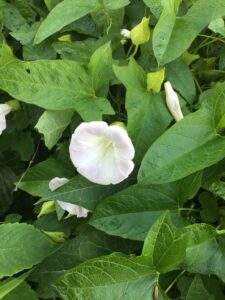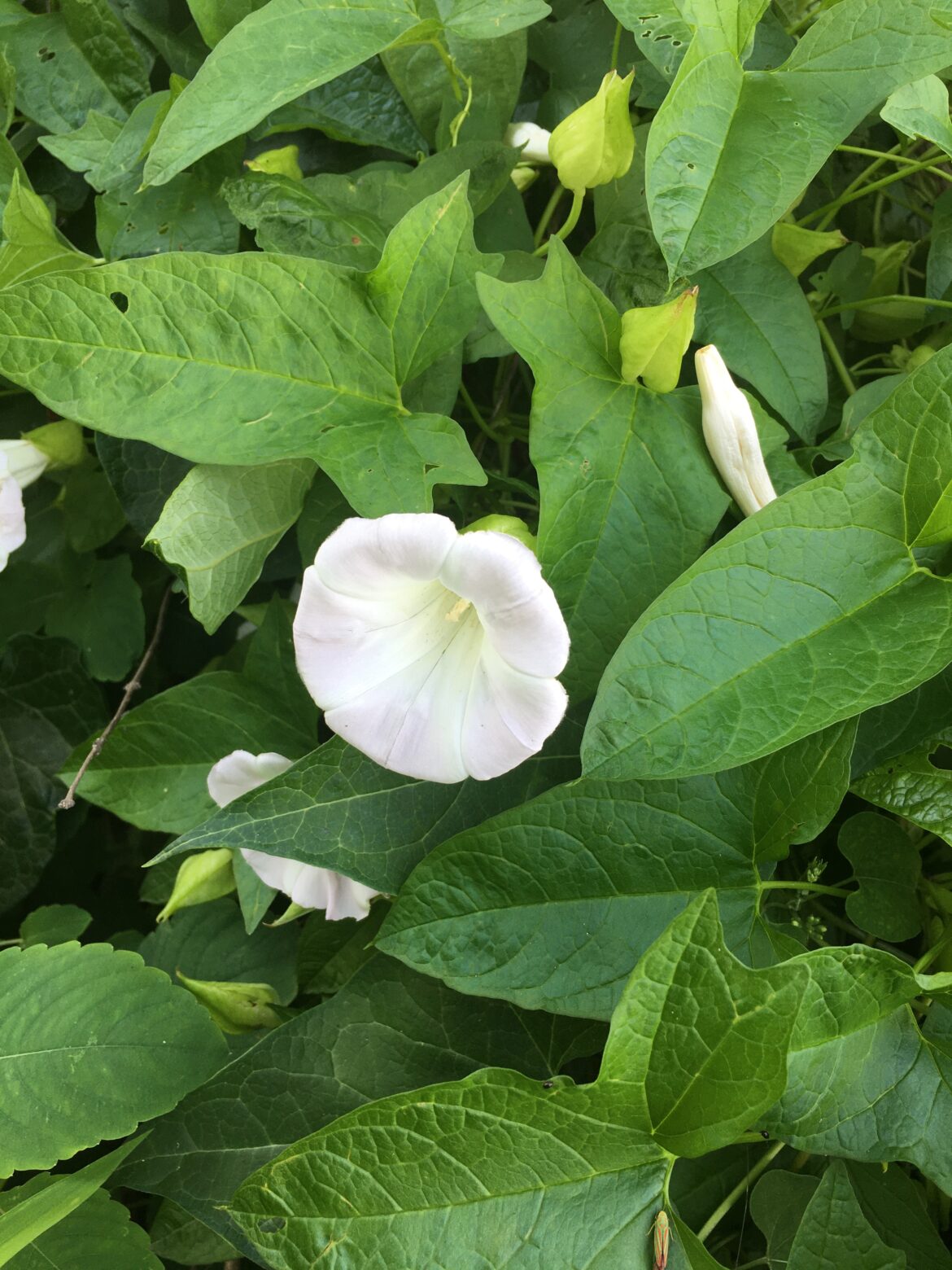July 7th
The 188th Day of the Year
Heard today the first cicada, quite faint, as if its first attempt. Frogs every morning. Where are they? Not far. They are the voice of summer.
Harlan Hubbard, along the Ohio River in Kentucky
Sunrise/set: 5:13/8:06
Day’s Length: 14 hours 53 minutes
Average High/Low: 85/64
Average Temperature: 74
Record High: 100 – 1988
102 – 2012
Record Low: 48 – 1983
Weather
Today’s temperature distribution: 70s on 25 percent of the afternoons, 80s on 30 percent, 90s on 40 percent, and 100s on five percent. Morning lows are the 50s half the time, so the night of July 6 – 7 is often one of the more pleasant July nights for sleeping. The sky is clear to partly cloudy 90 percent of the time, making July 7th the brightest day of the month. Thunderstorms, however, are not uncommon; one year in three brings rain today.
Natural Calendar
All across America now, endless bloom: Purple loosestrife, lizard’s tail, Queen Anne’s lace, purple coneflower, wild petunia, bouncing bet, dayflower, sow thistle, white vervain, dogbane, black-eyed Susan, leatherflower, figwort, lesser stitchwort, germander, pokeweed, St. John’s wort, teasel, wild lettuce, wood mint, wood nettle, leafcup, touch-me-not, lopseed and avens are blossoming in the woods and fields.
Throughout the Midwest, the first peaches and summer apples have started coming in. July’s wild cherries are ripening, and elderberry flowers have turned to small green berries. Along the West Coast, blackberries and salmon berries set fruit. May’s goslings and ducklings are almost grown in Michigan. In the Ohio Valley, the chatter of squirrels complements the morning birdsong.
Daybook
1982: Parsnip tops are all brown with seeds.
1984: South Glen: Ducklings almost full grown, angelica dying back, wild cherries just beginning to turn, elderberry setting fruit, coneflowers budding, first pokeweed and wood mint flowering in the deep woods. I touched a small brown butterfly with a red mark on its back wings; it was tame, drugged maybe by the sweetness of the milkweed flower it was sitting on. Crickets: steady song now. Yellow sweet clover fading with the parsnips. Buckeye leaves yellowing, wood nettle in bloom, timothy no longer easy to pull, nectar gone from the stem,
1986: First cicadas heard at 8:30 p.m.
1988: Grackles cackle in the back trees. Cardinal still singing through the day. In the drought, some redbud leaves are withering. More animals killed on the highway.
1990: First teasel opened today. Still no cicadas.
1991: From New York west across northern Pennsylvania, parsnips and yellow sweet clover are prominent. Horseweed is tall, not blooming. Knapweed is the dominant plant here, although sweet clover, daisies and crown vetch are also common. Late rhododendrons seen in the Pocono Mountains west of New York.
1993: Canadian thistles mostly gone to seed now along Dayton-Yellow Springs Road. Nodding thistles tattered. Red and yellow clovers are past their best, white sweet clover holding full.
1996: When I was cleaning up the pots and planting flats in the back yard, I found several daddy-longlegs with red, oblong egg-like parasites attached to their legs (found third week of June in 1997, mistakenly thought to be eggs). Canadian thistles and nodding thistles mostly to seed now.
1997: First day of Japanese beetles.
1999: White cabbage moths, sometime up to a dozen, cluster at the lavender and purple loosestrife in the north garden.
2000: Working at the nursing home: At 1:00 this morning, the frogs were only half as loud as they were at 11:00 last night. Then at 3:00, silence. One cricket heard at 4:00. At 4:30, the cardinal began by the back kitchen door, and one frog croaked. At 8:30, I heard the first cicadas. At suppertime, a black alypia found. At 11:00 p.m., back at work, a stag beetle on the back wall, a tree frog at the back door, and a smaller tree frog, maybe three-fourths of an inch, hopping not far behind it, and tame: it let me pet him.
2001: Rose of Sharon starts blooming.
2002: Driving east from Vancouver, British Columbia: Full blooming salmon berries in the mountains. Yucca flowering and cottonwood cotton floating in the breeze at Banff. Very last lilac blossoms seen in Calgary.
2004: Lilies, mallow and mid-season hostas continue at their peak. Cut-back sweet rocket continues to bloom here and there.
2005: Rose of Sharon opened today in the north garden and along the street. The old solid green hostas started coming into bloom along the house. No cicadas yet. One small cricket seen in the garden.
2006: A cardinal sang at 4:13 a.m., then was silent; at 4:22 more consistent singing began. Robins were in chorus at 4:30. Weather clear and cool in the 50s. At South Glen, blackberries starting to redden, some black raspberries still not ripe (but almost gone in the alley). Yellow sweet clover almost ended above the Butterfly Preserve. Teasel still not in bloom. Water plantain has started to flower by the pond as lizard’s tail turns to seeds. Rudbeckia season has begun at Don Beard’s garden; a couple of the new plants planted from seed this spring are opening in our yard.
2008: Lilies continue to grow in number and variety, the daylilies offering the most color, but several yellow Asiatic-Oriental crosses are bright and very tall along the north wall. At the feeders, fledgling sparrows continue to flutter and beg for food. Alley black raspberries are getting old. Dark mulberries continue to fall heavily. Violet monarda is coming in slowly, while the red monarda has been in full flower for at least a week. Phillipe, the frog, seen on the porch, out hunting; later heard in the pond. Fireflies numerous when I walked Bella about 9:30 this evening, the young moon lying in the west. The first hurricane of the season, Bertha, has formed in the middle Atlantic. Its path is north and west, and it is expected to miss the coast of North America.
2010: Joe Pye blushing as oakleaf hydrangea petals redden.
2011: 4:10 faint robinsong, 4:15 – one cardinal song, then robins getting louder, 4:45 – another cardinal call, then a gradual increase in cardinal vocalizations through the neighborhood, a song sparrow about 4:50, and then the house sparrows started in, and then the hummingbirds started arriving, chattering as they reached the feeders. By 5:00, cardinals and sparrows boisterous, then quieting to come and go in waves. At 8:45, I heard the first cicadas of the summer. Ramps in late bloom, ditch lilies late bloom. Brief showers of locust leaves this afternoon.
2012: At 4:30, first cardinals, the purr of tree frogs and the faint singsong of robins, birds in full voice by 4:40, crows joining in. Thirty-six lilies this morning, the varieties slowly receding, even though the number of blooms remains strong. The white phlox came in a day or so ago, and now all the phlox, the pink and red and white, are filling in for some of absences as Deep Summer deepens. In the alley, Japanese knotweed is still in bloom, and the earliest flowers have appeared on the dusky-leafed plant behind Liz’s garage. Along the way to Dayton, many cornfields are becoming stressed by the heat, and in the city, many lawns are brown. All the leaves have fallen from the roadside sweet clover, and the hemlock stems have all turned brown. In the dooryard garden, the earliest and most beautiful of the daylilies, a pale orange-pink has completed its blossoming cycle. Tonight, when I walked Bella just before midnight, I heard katydids in the distance.
2013: Between 4:30 and 5:00 this morning, cardinals were louder than robins, a strong bird chorus with an underlayment of tree crickets. The garden lilies seem to be at their peak, with twenty-six varieties in bloom, the Asiatics probably the most notable absence, eaten off by deer or choked out. No katydids heard on a short walk about 9:00 p.m.
2014: Twenty-five lilies in flower this morning, the ditch lilies here coming quickly to a close, started to open on June 15th at Moya’s, will probably complete a four-week season this week.
2015: First field cricket of the season heard as I jogged along Greene Street. No tree crickets heard so far this year. Forty lilies in bloom this morning. Only a handful of ditch lily blossoms left. I saw the hummingbird moth in the bee balm again, got a few photos – I hope. After a brief rain this afternoon: a bright tiger swallowtail sat spread-wing on a bee balm flower; a few feet over, the hummingbird moth worked the blooms.
2017: Returning from New York: The deer has taken a few more of the lilies, but most of them are all right. One hundred thirty-two day lily blossoms this afternoon, seven late (and slightly darker) ditch lilies. Three zinnias have opened all the way, several more Shasta daisies. The monarda is sagging from all the rain of the past two days, but it is still in full flower. At the store, the Kentucky coffee tree has long, soft, green seeds.
2018: One hundred and seventy-seven day lily blossoms, four ditch lilies, four Asiatics. The first hollyhock is budding, the first canna is completely open, zinnias gathering momentum to take over from the lilies. Robins peeping and clucking all day, sparrows chanting non-stop. One small spicebush butterfly near the lilies in the morning, one monarch floating past Jill’s back porch this afternoon. The first purple phlox, transplanted last year to save it from beetles, has put out three blooms.
2019: High 80s and more high humidity today: 137 day lilies open, three tree lilies, 63 ditch lilies.
2020: The standard mid-season hostas opened today all around the yard. Lily count: 142 day lily, 3 Asiatic, 60 ditch lily blossoms. Tall zinnias just beginning, Oklahoma zinnias early bloom, disappointingly small. At Ellis Pond, bindweeds are blooming, tangled in the touch-me-not foliage.
The spring flowers, the autumn moon;
Summer breezes, winter snow.
If useless things do not clutter your mind,
You have the best days of your life.
Mumon/ trans. Katsuki Sekida


